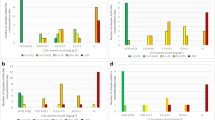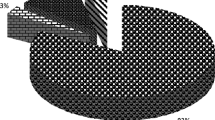Abstract
Chlordecone (CLD) is an organochlorine pesticide whose extended use led to the contamination of at least 20 % of agricultural soils from the French West Indies. Livestock reared on polluted areas are involuntary contaminated by CLD and their level of contamination may exceed the threshold values set by the European Union. Thus, characterizing the CLD behaviour in farm animals appear as a real issue in terms of food safety for local populations. The aim of this experiment was (i) to characterize the CLD disappearance in various tissues after exposure cessation and (ii) to evaluate the potential effect of body fatness on this process. Two groups of eight growing goats were submitted to either a basal diet or a high energy diet for 50 days before being intravenously contaminated with 1 mg CLD kg−1 body weight. Two days after CLD contamination, half of the kids of each experimental group were slaughtered in order to determine pollutant levels in the serum, liver, adipose tissues, and empty carcass. The remaining animals were submitted to a 30-day decontamination period before slaughtering and measurements as described above. The implemented nutritional plan resulted in both groups of kids with significant differences in terms of body fatness. CLD was mainly concentrated in the liver of animals as described in the literature. It was found also in kids’ empty carcass and adipose tissues; however its levels in the empty carcass (muscles and bones) were unexpected since they were higher than in fat. These results indicate that the lipophilic pollutant CLD is found mainly in liver but also in muscles and fat. Concerning the animals’ depuration, a 30-d decontamination period was sufficient to observe a decrease of CLD levels by more than 75 % in both experimental groups and neither CLD concentrations nor CLD amounts were significantly affected by kids’ body fatness.

Similar content being viewed by others
Abbreviations
- AT:
-
Adipose tissues
- BD:
-
Basal diet
- BW:
-
Body weight
- CLD:
-
Chlordecone
- CLD-OH:
-
Chlordecone-alcohol
- DM:
-
Dry matter
- FM:
-
Fat matter
- HED:
-
High energy diet
- LOQ:
-
Limit of quantification.
References
Alberghina D, Casella S, Vazzana I, Ferrantelli V, Giannetto C, Piccione G (2010) Analysis of serum proteins in clinically healthy goats (Capra hircus) using agarose gel electrophoresis. Vet Clin Path 39(3):317–321
Bas P, Rouzeau A, Morand-fehr P (1985) Weight and metabolism of fat reserves during the growth of kids (goats) (in French). Reprod Nutr Dev 25(1B):275–285
Bauchart D (1993) Lipid absorption and transport in ruminants. J Dairy Sci 76(12):3864–3881
Bocquené G, Franco A (2005) Pesticide contamination of the coastline of Martinique. Mar Pollut Bull 51(5):612–619
Bordet F, Thieffinne A, Mallet J, Heraud F, Blateau A, Inthavong D (2007) In-house validation for analytical methods and quality control for risk evaluation of chlordecone in food. Int J Environ Anal Chem 87(13–14):985–998
Bouveret C, Rychen G, Lerch S, Jondreville C, Feidt C (2013) Relative bioavailability of tropical volcanic soil-bound chlordecone in piglets. J Agr Food Chem 61(38):9269–9274
Cabidoche YM, Achard R, Cattan P, Clermont-Dauphin C, Massat F, Sansoulet J (2009) Long-term pollution by chlordecone of tropical volcanic soils in the French West Indies: a simple leaching model accounts for current residue. Environ Pollut 157(5):1697–1705
Coat S, Monti D, Legendre P, Bouchon C, Massat F, Lepoint G (2011) Organochlorine pollution in tropical rivers (Guadeloupe): role of ecological factors in food web bioaccumulation. Environ Pollut 159(6):1692–1701
Commission Regulation (EC) n° 839/2008 (2008) Commission Regulation (EC) n° 839/2008 of 31 July 2008 amending Regulation (EC) n° 396/2005 of the European Parliament and of the Council as regards Annexes II, III and IV on maximum residue levels of pesticides in or on certain products. Off J Eur Union, L234:1–216
Dallaire R, Muckle G, Rouget F, Kadhel P, Bataille H, Guldner L, Cordier S (2012) Cognitive, visual, and motor development of 7-month-old Guadeloupean infants exposed to chlordecone. Environ Res 118:79–85
Dubuisson C, Héraud F, Leblanc JC, Gallotti S, Flamand C, Blateau A, Quenel P, Volatier JL (2007) Impact of subsistence production on the management options to reduce the food exposure of the Martinican population to Chlordecone. Regul Toxicol Pharm 49(1):5–16
Folch J, Lees M, Sloane-Stanley GH (1957) A simple method for the isolation and purification of total lipids from animal tissues. J Biol Chem 226(1):497–509
Guzelian PS (1982) Comparative toxicology of chlordecone (Kepone) in humans and experimental animals. Annu Rev Pharmacol Toxicology 22(1):89–113
Hocquette JF, Bauchart D (1999) Intestinal absorption, blood transport and hepatic and muscle metabolism of fatty acids in preruminant and ruminant animals. Reprod Nutr Dev 39(1):27–48
IPCS (1984) Environmental Health Criteria 43 (EHC 43): Chlordecone International Programme on Chemical Safety. United Nations Environment Programme. International Labour Organisation. World Health Organization
Jondreville C, Fournier A, Mahieu M, Feidt C, Archimède H, Rychen G (2014a) Kinetic study of chlordecone orally given to laying hens (Gallus domesticus). Chemosphere 114:275–281
Jondreville C, Lavigne A, Jurjanz S, Dalibard C, Liabeuf JM, Clostre F, Lesueur-Jannoyer M (2014b) Contamination of free-range ducks by chlordecone in Martinique (French West Indies): a field study. Sci Total Environ 493:336–341
Jurjanz S, Jondreville C, Mahieu M, Fournier A, Archimède H, Rychen G, Feidt C (2014) Relative bioavailability of soil-bound chlordecone in growing lambs. Environ Geochem Hlth 36:911–917
Kleiber M (1947) Body size and metabolic rate. Physiol Rev 27(4):511–541
Le Deaut JY, Procaccia C (2009) Impacts of the use of chlordecone and pesticides in West Indies: state of the art and prospective (in French). Office parlementaire d'évaluation des choix scientifiques et technologiques., p 223
McFarland LZ, Lacy PB (1969) Physiologic and endocrinologic effects of the insecticide kepone in the Japanese quail. Toxicol Appl Pharm 15(2):441–450
Mills GL, Taylaur CE (1971) The distribution and composition of serum lipoproteins in eighteen animals. Comp Biochem Phys Part B: Comparative Biochemistry 40(2):489–501
Morand-Fehr P, Bas P, Rouzeau A, Hervieu J (1985) Development and characteristics of adipose deposits in male kids during growth from birth to weaning. Anim Prod 41(03):349–357
Multigner L, Ndong JR, Giusti A, Romana M, Delacroix-Maillard H, Cordier S, Jégou B, Thome JP, Blanchet P (2010) Chlordecone exposure and risk of prostate cancer. J Clin Oncol 28(21):3457–3462
Naber EC, Ware GW (1964) Effects of Kepone and Mirex on reproductive performance in the laying hen. Poultry Sci 44(3):875–880
Nakashima Y, Ikegami S (2003) High-fat diet enhances the accumulation of hexachlorobenzene (HCB) by pregnant rats during continuous exposure to HCB. J Agr Food Chem 51(6):1628–1633
Robelin J, Casteilla L (1990) Differentiation, growth and development of adipose tissue (in French). INRA Prod Anim 3(4):243–252
Rozman T, Rozman K, Smith GS (1983) Relationship of body weight to disposition of hexachlorobenzene in rats. Toxicol Lett 18(1):171–175
Skalsky HL, Fariss MW, Blanke RV, Guzelian PS (1979) The role of plasma proteins in the transport and distribution of chlordecone (kepone®) and other polyhalogenated hydrocarbons*. Ann N Y Acad Sci 320(1):231–237
Smith JC, Arant FS (1967) Residues of kepone in milk from cows receiving treated feed. J Econ Entomol 60(4):925–927
Soine PJ, Blanke RV, Schwartz CC (1983) Chlordecone metabolism in the pig. Toxicol Lett 17(1–2):35–41
Umegaki K, Ito T, Ikegami S, Ichikawa T (1993) Role of fat tissue mass on metabolism and excretion of lipophilic chemicals. Jpn J Tox Env Health 39(1):P21–P21
Urge M, Merkel RC, Sahlu T, Animut G, Goetsch AL (2004) Growth performance by Alpine, Angora, Boer and Spanish whether goats consuming 50 or 75 % concentrate diets. Small Ruminant Res 55(1):149–158
Vitić J, Stevanović J (1993) Comparative studies of the serum lipoproteins and lipids in some domestic, laboratory and wild animals. Comp Biochem Phys Part B: Comparative Biochemistry 106(1):223–229
Acknowledgments
The authors are grateful to the French Environment and Energy Management Agency (ADEME) and INRA “PHASE” for financial support. They thank F. Dugny for goats breeding and experimental monitoring, H. Gros for her contribution and her strong investment during the experiment, J.-F. Rouaud and J. Liger (INRA, PEGASE) for grounding of matrices, P. Hartmeyer and C. Grandclaudon (INRA, Université de Lorraine, URAFPA) for technical support, the Departmental Analytical Laboratory of Morbihan (LDA 56, Saint-Ave, France), C. Adam and J.P. Thome (CART, Liège, Belgium) for chlordecone analyses.
Author information
Authors and Affiliations
Corresponding author
Ethics declarations
The experimental protocol was approved by the Lorraine Ethics Committee (CELMEA) and the French Ministry of Higher Education and Research under the project number 00270.02.
Additional information
Responsible editor: Hongwen Sun
Rights and permissions
About this article
Cite this article
Lastel, ML., Lerch, S., Fournier, A. et al. Chlordecone disappearance in tissues of growing goats after a one month decontamination period—effect of body fatness on chlordecone retention. Environ Sci Pollut Res 23, 3176–3183 (2016). https://doi.org/10.1007/s11356-015-5833-4
Received:
Accepted:
Published:
Issue Date:
DOI: https://doi.org/10.1007/s11356-015-5833-4




